Recent Acquisitions at The Filson
By Estill Curtis Pennington
Visiting Curator of Portraiture and Decorative Arts
About |
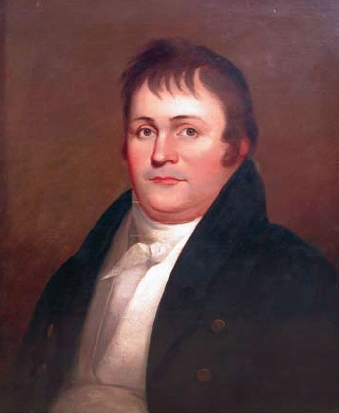 If
a picture paints a thousand words, a portrait surely tells at least one good
biography, and perhaps a detective story as well.
If
a picture paints a thousand words, a portrait surely tells at least one good
biography, and perhaps a detective story as well.
In the case of several recent acquisitions to The Filson holdings, the portraits donated demonstrate how much of that biography can be lost and then recovered, and some of those mysteries solved. As a portrait is a visual account of the sitter’s circumstances and the artist’s abilities, the trail is never too far beneath the mouldering varnish.
In the case of the portrait of Major William Preston, the path is seemingly clear. Preston, who was made a captain in the army by George Washington during the Revolution, came in Kentucky after the War of 1812. He and his wife, Caroline Hancock took up residence in the Louisville area on land granted to Preston’s father for service in the French and Indian Wars. Described as “vigorous, with a gifted intellect” he was also of “great stature”, and while on a visit to Virginia in 1821 he died, presumably from complications brought on by his huge girth, amply apparent in the portrait by Joseph Henry Bush. By family tradition, duly reported by Edna T. Whitley in Kentuky Ante- Bellum Portraiture, Preston was painted sometime between 1815 and 1821.
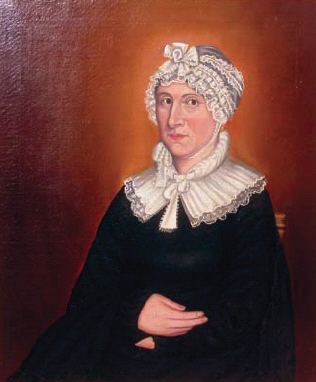 Caroline
Hancock
Preston, who
lived on for
another 26
years, had
her portrait
painted by
Bush at a
high point in
his Louisville
popularity,
sometime
near 1835.
The bold
placement
of the head,
the hair style,
and costume
details, especially
the lacy
cap, collar
and bow, are
all in accord
with the period. But the very size
of her portrait, exactly matching
that of her husband, brings
into doubt the previous dating
of that work. Between 1815 and
1821 Bush was in Philadelphia,
Lexington, and, briefly, Louisville.
He is unlikely to have painted
Preston from life at that time. It
is far more likely that his widow
commissioned a portrait “from a
miniature or another painting”
as a pendant to her own likeness,
according to William Barrow
Floyd, in his monograph on Bush.
Caroline
Hancock
Preston, who
lived on for
another 26
years, had
her portrait
painted by
Bush at a
high point in
his Louisville
popularity,
sometime
near 1835.
The bold
placement
of the head,
the hair style,
and costume
details, especially
the lacy
cap, collar
and bow, are
all in accord
with the period. But the very size
of her portrait, exactly matching
that of her husband, brings
into doubt the previous dating
of that work. Between 1815 and
1821 Bush was in Philadelphia,
Lexington, and, briefly, Louisville.
He is unlikely to have painted
Preston from life at that time. It
is far more likely that his widow
commissioned a portrait “from a
miniature or another painting”
as a pendant to her own likeness,
according to William Barrow
Floyd, in his monograph on Bush.
The Preston case is easy to sort. With known sitters, and a known artist, the only real question concerns dating. Far more challenging is determining who the artist is in the case of the portraits of Elizabeth Wood and her husband Captain Benjamin Bayless. They were married in 1798 and settled in the Maysville vicinity in the first decade of the 19th century. But when were they painted and by whom?
To detect the artist there
are certain facts which can be
established and specific questions
which can be established. Dating
the portrait can be accomplished
by 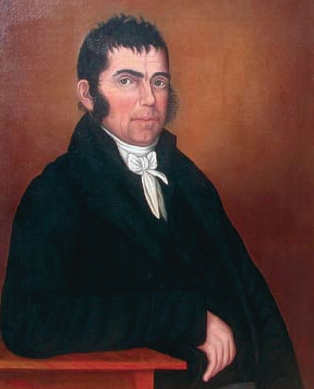 examination of costume and
speculation on appearance. The
gentleman’s stock and the lady’s
lacy cap would seem to date from
the 1810-1820 era, and is not unlike
attire seen in other portraits
of that period.
If painted in that
decade, the general
appearance
of the couple
as individuals in
their early to late
30s is not unreasonable.
But if
from that era, by
whose hand?
examination of costume and
speculation on appearance. The
gentleman’s stock and the lady’s
lacy cap would seem to date from
the 1810-1820 era, and is not unlike
attire seen in other portraits
of that period.
If painted in that
decade, the general
appearance
of the couple
as individuals in
their early to late
30s is not unreasonable.
But if
from that era, by
whose hand?
Answering that question requires a survey of place. Who was painting in that area at that time? On June 20, 1817, John T. Turner, of Cincinnati, advertises that he has set up at the house of Jacob Boone in Maysville, offering “portrait painting as large as life, and ornamental…” Clearly an itinerant, Turner advises those wanting portraits, that the “sooner the application, the better as they contemplate leaving this place in a few weeks…” Thanking any potential sitters in advance, he also notes his gratitude to those who “have already afforded (him) encouragement,” from which we can deduce that there was extant work at hand.
Like other itinerants, Turner was a master of many decorative arts, including sign painting, the cutting of silhouettes, and fancy painting on furniture. This type of work requires a sharp attention to detail, and strong contrasting which sets off the subject in a vivid manner so as to attract the eye. Both Bayless subjects have a strong light behind their heads giving them a golden radiance which truly adds depth to the background. They are also painted in intense detail, a detail so specific as to invite attributions of naive realism, that “honesty” so admired in the annals of taking a likeness in that age.
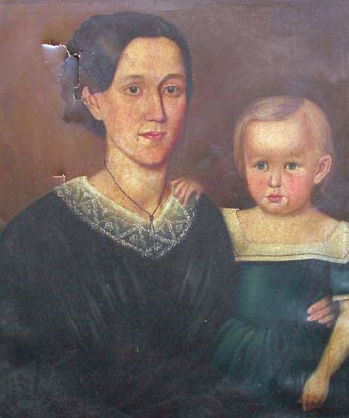 However, there is still another,
and highly intriguing, connection
to be made between Turner and
other artists in the area. Aaron
Houghton Corwine was a child
prodigy reputed by oral and
antiquarian history to have had
his first instruction from an artist,
Turner, visiting Maysville from
Cincinnati. Taking Turner’s advice,
Corwine moved to Cincinnati
in 1817, where he gained the
patronage of Turner’s friend Dr.
Daniel Drake.
However, there is still another,
and highly intriguing, connection
to be made between Turner and
other artists in the area. Aaron
Houghton Corwine was a child
prodigy reputed by oral and
antiquarian history to have had
his first instruction from an artist,
Turner, visiting Maysville from
Cincinnati. Taking Turner’s advice,
Corwine moved to Cincinnati
in 1817, where he gained the
patronage of Turner’s friend Dr.
Daniel Drake.
What might this connection prove? A younger artist could observe the process of placing a head, raising color, and applying detail. Corwine’s early work is also characterized by a strong light behind the head, which also gives high relief and adds a luminous depth to the background, a stylistic conceit he passed along to his protégé Alonzo Douglass. These lessons in likeness can be called verisimilitude of detail, and while they do not provide primary, empirical, evidence in the form of signatures, invoices, or correspondence, they do allow a possible artist attribution. Until definitively disputed, the Bayless attribution goes to Turner.
Geographic proximity of available artist and willing sitter again plays an important role in the identification of the painter of the Nelson family portraits.
Hugh and Mary Wallace Nelson were native Virginians who moved to Christian County, Kentucky, c. 1845. In the pair of pendant portraits Mrs. Nelson is holding her son, Memucan Hunt Nelson.
Of the two portrait artists associated
with ante-bellum Christian
County, one, James Thomas Poindexter, could be considered too
young and inexperienced to have
painted these works. Poindexter
was born in 1832, and the child,
M. Hunt Nelson born in 1847,
appears to be at least two years old
in the portrait. Whether Poindexter
had the ability at 17 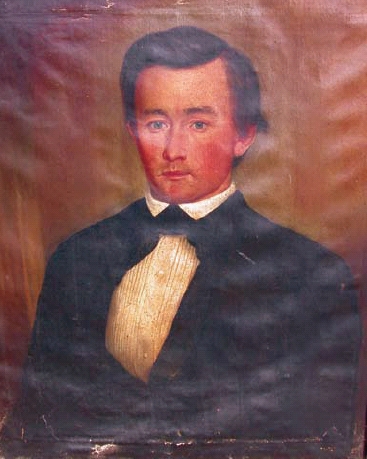 to paint
this work is further obscured by
the fact that few portraits by him
appear until after the Civil War.
to paint
this work is further obscured by
the fact that few portraits by him
appear until after the Civil War.
A far more likely candidate is George Wilhelm Frye, an artist of German origin who first appears in Louisville in the mid 1840s. Unlike better known artists, such as Oliver Frazer and Joseph Henry Bush, Frye did not pursue an itinerancy in central Kentucky, but traveled further southwest, working in western Kentucky and the northern plains of Alabama and Tennessee. Frye could be a vivid colorist in the Germanic tradition, but he attempted little in the way of compositional ambition and may have worked from daguerreotypes, which would contribute to the sense of flatness. A consistent similarity of compositional anatomical detail is apparent in his work, especially in the interlocking dependency of his mothers and children. His male figures are also rather consistently placed high on the planar field, and with a severe, straight forward dignity.
All five of these works are welcome additions to The Filson collection. Each reasonable artist attribution made for portraits of this type provide a further foundation for assisting many owners of unidentified portraits in solving a compounded biographical mystery. Of course contributions for careful restoration are also welcome!
The Filson Historical Society
1310 South Third Street - Louisville, KY 40208
Phone: (502) 635-5083 Fax: (502) 635-5086
Hours
The Ferguson Mansion and Office
Monday - Friday: 9 am. - 5 pm.
Saturday and Sunday closed
Library
Monday - Friday: 9 am. - 5 pm.
Saturday: 9 am. - 12 noon
